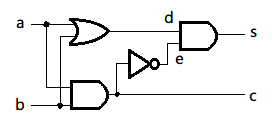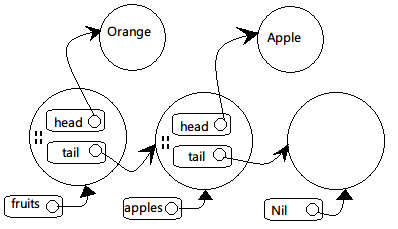有状态的对象、实现列表
有状态的对象
类似于JavaBean的getter和setter方法,Scala对象的非私有var x有自动生成的访问方法
x和设值方法x_=。
对于类中的字段:
var hour = 12
会有额外的getter方法hour和setter方法hour_=。方法的访问性与字段一致。
拿这个例子来说:
class Time {
var hour = 12
var minute = 0
}
和下面的代码是一样的:
class Time {
private[this] var h = 12
private[this] var m = 0
def hour: Int = h
def hour_=(x: Int) { h = x }
def minute: Int = m
def minute_=(x: Int) { m = x }
}
所以可以直接定义getter和setter。
下面的代码在setter前进行检查:
class Time {
private[this] var h = 12
private[this] var m = 12
def hour: Int = h
def hour_= (x: Int) {
require(0 <= x && x < 24)
h = x
}
def minute = m
def minute_= (x: Int) {
require(0 <= x && x < 60)
m = x
}
}
再看一个温度的例子:
class Thermometer {
var celsius: Float = _
def fahrenheit = celsius * 9 / 5 + 32
def fahrenheit_= (f: Float) {
celsius = (f - 32) * 5 / 9
}
override def toString = fahrenheit +"F/"+ celsius +"C"
}
注意:变量celsius的值为_,表示初始化值。对于数值代表0,对于布尔类型代表
false,引用类型则代表null。
Scala中的初始化器=_,如果写成:
var celsius
这样就成了抽象变量(以后到了「抽象成员」这一章介绍),而不是一个没有初始化的变量。 这个和Java的习惯很不一样。
使用的例子:
scala> val t = new Thermometer t: Thermometer = 32.0F/0.0C scala> t.celsius = 100 scala> t res3: Thermometer = 212.0F/100.0C scala> t.fahrenheit = -40 scala> t res4: Thermometer = -40.0F/-40.0C
案例:离散事件模拟
来个SICP(Structure and Interpretation of Computer Programs,计算机程序的构造与 解释)里的例子。
为数字电路定制语言

为了实现这三种基本的门,我们建立一个Wire类代表线路。可以这样构造线路:
val a = new Wire val b = new Wire val c = new Wire
或简洁地写成:
val a, b, c = new Wire
三个基本的门电路由以下三个过程模拟:
def inverter(input: Wire, output: Wire) def andGate(a1: Wire, a2: Wire, output: Wire) def orGate(o1: Wire, o2: Wire, output: Wire)
注意这里的过程都没有返回值。按照函数式的思想,应该是返回构造好的门对象。但是在
这里我们选择了没有返回值,而是通过副作用来模拟门电路。副作用让一步步渐进地构造
复杂的电路更加容易,如inverter(a,b)在a与b之间放置反转电路。
还有这里的方法名没有用动词而是用了名词,这是为了方便说明制造的是哪个门电路。这 反映了DSL说明的本质:应该描述电路,而不是如何制造它。
下面是一个半加法器(half-adder)。它根据两个输入a和b产生累加和s。
累加的定义为:s= (a+b)%2及进位c,其中的c = (a+b)/2。
半加法器电路图:

用我们的代码描述:
def halfAdder(a: Wire, b: Wire, s: Wire, c: Wire) {
val d, e = new Wire
orGate(a, b, d)
andGate(a, b, c)
inverter(c, e)
andGate(d, e, s)
}
接下来是一个全加法器,定义为根据参数a和b还有进位cin得到两个输出。一个是和
sum = (a+b+cin)%2,另一个是进位输出count = (a+b+cin)/2:

代码为:
def fullAdder(a: Wire, b: Wire, cin: Wire,
sum: Wire, cout: Wire) {
val s, c1, c2 = new Wire
halfAdder(a, cin, s, c1)
halfAdder(b, s, sum, c2)
orGate(c1, c2, cout)
}
这是内部DSL很好的例子:通过宿主语言将特定的语言定义为库面不是完全实现这种语言。
Simulation API
完成了对电路的模拟以后,再来分析对时间的模拟。模拟时间包括在指定时间执行指定的 动作。
私有变量保存时间,但提供对时间的公开访问:
private var curtime: Int = 0 def currentTime: Int = curtime
定义动作:在我们的例子中,把参数列表和返回都为空的过程() => Unit作为基本的动作
。给这样类型的过程起个别名叫Action:
type Action = () => Unit
在特定时间执行的的操作定义为工作项目(work item):
case class WorkItem(time: Int, action: Action)
注意这里用的是样本类,所以用工厂方法创建实例就可以自动获得访问构造器参数time和
action的方法。
还有一个类来保存末执行工作条目的排程表(agenda),注意它是按时间排序的:
private var agenda: List[WorkItem] = List()
提供在一定 时延后加入新的工作条目的方法,注意加入操作也要排序:
def afterDelay(delay: Int)(block: => Unit) {
val item = WorkItem(currentTime + delay, () => block)
agenda = insert(agenda, item)
}
private def insert(ag: List[WorkItem],
item: WorkItem): List[WorkItem] = {
if (ag.isEmpty || item.time < ag.head.time) item :: ag
else ag.head :: insert(ag.tail, item)
}
核心是run方法:
def run() {
afterDelay(0) {
println("*** simulation started, time = "+
currentTime +" ***")
}
while (!agenda.isEmpty) next()
}
private def next() {
(agenda: @unchecked) match {
case item :: rest =>
agenda = rest
curtime = item.time
item.action()
}
}
注意这里为了方便去掉了空列表的情况。为了防止编译器警告我们在模式匹配里故意漏掉了
列表为空的情况,在这里使用了(agenda: @unchecked) match而不是agenda match。
完整的代码在包org.stairwaybook.simulation里:
abstract class Simulation {
type Action = () => Unit
case class WorkItem(time: Int, action: Action)
private var curtime = 0
def currentTime: Int = curtime
private var agenda: List[WorkItem] = List()
private def insert(ag: List[WorkItem],
item: WorkItem): List[WorkItem] = {
if (ag.isEmpty || item.time < ag.head.time) item :: ag
else ag.head :: insert(ag.tail, item)
}
def afterDelay(delay: Int)(block: => Unit) {
val item = WorkItem(currentTime + delay, () => block)
agenda = insert(agenda, item)
}
private def next() {
(agenda: @unchecked) match {
case item :: rest =>
agenda = rest
curtime = item.time
item.action()
}
}
def run() {
afterDelay(0) {
println("*** simulation started, time = "+
currentTime +" ***")
}
while (!agenda.isEmpty) next()
}
}
电路模拟
这里创建了BasicCircuitSiomulation来模拟电路。
为了模拟电路和延迟声明了三个方法:InverterDelay、AndGateDelay、OrGateDelay。由于
不同模拟电路的技术参数不同,所以这三个方法是抽象方法。
Wire类
需要支持的三种基本动作:
getSignal: Boolean:返回当前线路上的信号。
setSignal(sig: Boolean):设置线路信号。
addAction(p: Action):添加动作到线路上。基本思想是所有附加在某线路上的动作过程
在每次信号改变时被执行。通过连接组件可以为线路添加该组件的功能。加上的动作会在被
加到线路时以及每次线路信号改变时被执行。
实现代码sigVal代表当前信号,actions是附加的动作过程。需要注意的是setSignal
方法,当信号改变时,新的信号首先被保存在变量sigVal中,然后执行所有线路附加
动作:
class Wire {
private var sigVal = false
private var actions: List[Action] = List()
def getSignal = sigVal
def setSignal(s: Boolean) =
if (s != sigVal) {
sigVal = s
actions foreach (_ ())
}
def addAction(a: Action) = {
actions = a :: actions
a()
}
}
注意上面的缩写格式:actions forearch(_())代表对每个元素执行_()。在「函数和装饰」这一章的
「占位符」部分说明过,函数_()是f => f()的缩写,代表空参数函数。
反转操作
inverter方法会在安装之后以及每次线路信号变化时被调用。它通过setSignal把输出设为输入的反值。
另外,由于还要模拟电路的响应时间,所以输入值改变以后,还要等InverterDelay单位的模拟时间后,
才发生改变:
def inverter(input: Wire, output: Wire) = {
def invertAction() {
val inputSig = input.getSignal
afterDelay(InverterDelay) {
output setSignal !inputSig
}
}
input addAction invertAction
}
注意这里的afterDelay方法是把这个操作加到队列的最后面。
与门和或门操作
大致思想和上面类似:
def andGate(a1: Wire, a2: Wire, output: Wire) = {
def andAction() = {
val a1Sig = a1.getSignal
val a2Sig = a2.getSignal
afterDelay(AndGateDelay) {
output setSignal (a1Sig & a2Sig)
}
}
a1 addAction andAction
a2 addAction andAction
}
def orGate(o1: Wire, o2: Wire, output: Wire) {
def orAction() {
val o1Sig = o1.getSignal
val o2Sig = o2.getSignal
afterDelay(OrGateDelay) {
output setSignal (o1Sig | o2Sig)
}
}
o1 addAction orAction
o2 addAction orAction
}
模拟输出
通过探针(probe)观察线路上信号的改变。
还是在信号改变时被调用,显示输出线路的名称、模拟时间、信号值:
def probe(name: String, wire: Wire) {
def probeAction() {
println(name +" "+ currentTime +
" new-value = "+ wire.getSignal)
}
wire addAction probeAction
}
运行模拟器
BasicCircuitSimulation继承了CircuitSimulation
package org.stairwaybook.simulation
abstract class CircuitSimulation
extends BasicCircuitSimulation {
def halfAdder(a: Wire, b: Wire, s: Wire, c: Wire) {
val d, e = new Wire
orGate(a, b, d)
andGate(a, b, c)
inverter(c, e)
andGate(d, e, s)
}
def fullAdder(a: Wire, b: Wire, cin: Wire,
sum: Wire, cout: Wire) {
val s, c1, c2 = new Wire
halfAdder(a, cin, s, c1)
halfAdder(b, s, sum, c2)
orGate(c1, c2, cout)
}
}
剩下的电路延迟时间和定义被模拟的电路都留在Scala交互Shell中实现:
scala> import org.stairwaybook.simulation._ import org.stairwaybook.simulation._
定义延迟时间:
scala> object MySimulation extends CircuitSimulation {
| def InverterDelay = 1
| def AndGateDelay = 3
| def OrGateDelay = 5
| }
defined module MySimulation
定义一下简化以后对MySimulation的引用:
scala> import MySimulation._ import MySimulation._
定义线路的部分。先定义四根线路,再把探针放在其中的两根上。探针会立即输出结果:
scala> val input1, input2, sum, carry = new Wire
input1: MySimulation.Wire =
simulator.BasicCircuitSimulation$Wire@111089b
input2: MySimulation.Wire =
simulator.BasicCircuitSimulation$Wire@14c352e
sum: MySimulation.Wire =
simulator.BasicCircuitSimulation$Wire@37a04c
carry: MySimulation.Wire =
simulator.BasicCircuitSimulation$Wire@1fd10fa
scala> probe("sum", sum)
sum 0 new-value = false
scala> probe("carry", carry)
carry 0 new-value = false
加上半加法器:
scala> halfAdder(input1, input2, sum, carry)
逐次把两根输入线信号设为true,并执行模拟过程:
scala> input1 setSignal true scala> run() *** simulation started, time = 0 *** sum 8 new-value = true scala> input2 setSignal true scala> run() *** simulation started, time = 8 *** carry 11 new-value = true sum 15 new-value = false
全部代码如下:
package org.stairwaybook.simulation
abstract class BasicCircuitSimulation extends Simulation {
def InverterDelay: Int
def AndGateDelay: Int
def OrGateDelay: Int
class Wire {
private var sigVal = false
private var actions: List[Action] = List()
def getSignal = sigVal
def setSignal(s: Boolean) =
if (s != sigVal) {
sigVal = s
actions foreach (_ ())
}
def addAction(a: Action) = {
actions = a :: actions
a()
}
}
def inverter(input: Wire, output: Wire) = {
def invertAction() {
val inputSig = input.getSignal
afterDelay(InverterDelay) {
output setSignal !inputSig
}
}
input addAction invertAction
}
// continued in Listing 18.10...
// ...continued from Listing 18.9
def andGate(a1: Wire, a2: Wire, output: Wire) = {
def andAction() = {
val a1Sig = a1.getSignal
val a2Sig = a2.getSignal
afterDelay(AndGateDelay) {
output setSignal (a1Sig & a2Sig)
}
}
a1 addAction andAction
a2 addAction andAction
}
def orGate(o1: Wire, o2: Wire, output: Wire) {
def orAction() {
val o1Sig = o1.getSignal
val o2Sig = o2.getSignal
afterDelay(OrGateDelay) {
output setSignal (o1Sig | o2Sig)
}
}
o1 addAction orAction
o2 addAction orAction
}
def probe(name: String, wire: Wire) {
def probeAction() {
println(name +" "+ currentTime +
" new-value = "+ wire.getSignal)
}
wire addAction probeAction
}
}
abstract class Simulation {
type Action = () => Unit
case class WorkItem(time: Int, action: Action)
private var curtime = 0
def currentTime: Int = curtime
private var agenda: List[WorkItem] = List()
private def insert(ag: List[WorkItem],
item: WorkItem): List[WorkItem] = {
if (ag.isEmpty || item.time < ag.head.time) item :: ag
else ag.head :: insert(ag.tail, item)
}
def afterDelay(delay: Int)(block: => Unit) {
val item = WorkItem(currentTime + delay, () => block)
agenda = insert(agenda, item)
}
private def next() {
(agenda: @unchecked) match {
case item :: rest =>
agenda = rest
curtime = item.time
item.action()
}
}
def run() {
afterDelay(0) {
println("*** simulation started, time = "+
currentTime +" ***")
}
while (!agenda.isEmpty) next()
}
}
abstract class CircuitSimulation
extends BasicCircuitSimulation {
def halfAdder(a: Wire, b: Wire, s: Wire, c: Wire) {
val d, e = new Wire
orGate(a, b, d)
andGate(a, b, c)
inverter(c, e)
andGate(d, e, s)
}
def fullAdder(a: Wire, b: Wire, cin: Wire,
sum: Wire, cout: Wire) {
val s, c1, c2 = new Wire
halfAdder(a, cin, s, c1)
halfAdder(b, s, sum, c2)
orGate(c1, c2, cout)
}
}
object MySimulation extends CircuitSimulation {
def InverterDelay = 1
def AndGateDelay = 3
def OrGateDelay = 5
def main(args: Array[String]) {
val input1, input2, sum, carry = new Wire
probe("sum", sum)
probe("carry", carry)
halfAdder(input1, input2, sum, carry)
input1 setSignal true
run()
input2 setSignal true
run()
}
}
实现列表
列表不是Scala语言的内建结构,而是定义在Scala包中的List抽象类。它有一个子类
::和一个子对象Nil。
List类实现原理
本节的目的是实现一个简化的List实现:
package scala
abstract class List[+T] { ... }
作为一个抽象类List不能用像new List这样的空构造器构建,由类型参数[+T]表明
列表是协变的。
scala> val xs = List(1, 2, 3) xs: List[Int] = List(1, 2, 3) scala> var ys: List[Any] = xs ys: List[Any] = List(1, 2, 3)
实现的目标要有以下三个功能:
def isEmpty: Boolean
def head: T
def tail: List[T]
这三个方法在List类中是抽象的,被定义在Nil和::中。
Nil对象
Nil对象继承自List[Nothing],它定义了空列表。因为协变的作为它可以兼容任何类型
的List实例:
case object Nil extends List[Nothing] {
override def isEmpty = true
def head: Nothing =
throw new NoSuchElementException("head of empty list")
def tail: List[Nothing] =
throw new NoSuchElementException("tail of empty list")
}
成员方法head的实现方法是抛出异常,因为对于成员类型Nothing来说,返回结果必须
是Nothing,而Nothing是个根本不存在的类型,所以它无法正常返回结果,只能抛出
异常。
Cons类
::类读作「cons」,意思是「构造」,它实现了非空列表。「使用列表」这一章中「列表模式」里
说过模式中的每个中缀调用被作为构造器调用。
- 就是说:`x
- xs
是对类::的构造器调用::(x, xs)`。
final case class ::[T](hd: T, tl: List[T]) extends List[T] {
def head = hd
def tail = tl
override def isEmpty: Boolean = false
}
hd是头一个元素,tl是其他的所有元素。上面的代码可以简化,直接由参数实现超类
List的head和tail方法:
final case class ::[T](head: T, tail: List[T])
extends List[T] {
override def isEmpty: Boolean = false
}
其他的类方法
def length: Int =
if (isEmpty) 0 else 1 + tail.length
def drop(n: Int): List[T] =
if (isEmpty) Nil
else if (n <= 0) this
else tail.drop(n - 1)
def map[U](f: T => U): List[U] =
if (isEmpty) Nil
else f(head) :: tail.map(f)
列表构建
对于冒号结束的操作符::和:::,它们的操作都是绑定在右操作数上的。即:
x :: xs
被看作是:
xs.::(x)
因为x是列表元素可以是任意类型,所以不能假设它正好是具有::方法的
类型。也由于这个原因::方法应该生成一个新的列表。
还有值得讨论的地方是新加入元素的类型。思维惯性上会认为和列表元素是同一类型,但 实际上可用的范围更大。以下面的层级关系为例:
abstract class Fruit class Apple extends Fruit class Orange extends Fruit scala> val apples = new Apple :: Nil apples: List[Apple] = List(Apple@585fa9) scala> val fruits = new Orange :: apples fruits: List[Fruit] = List(Orange@cd6798, Apple@585fa9)
上面的例子说明新加入的元素可以产生超类类型的列表。实现这样弹性的::方法:
def ::[U >: T](x: U): List[U] = new scala.::(x, this)
注意方法本身是多态的,类型参数是U,添加的元素类型必须是U,返回结果类型是
List[U]。而[U >: T]限定列表元素T的超类。
结合前面的例子,U被实例化为Fruit。因为List[Apple]中的Apple是Fruit的
子类,于是U的下界被满足。

实际上对带有下界的T定义不只是为了方便,更加是为类型正确。因为List是协变的,
如果用下面的形式:
// Error def ::(x: T): List[T] = new scala.::(x, this)
因为方法参数被认为是逆变位置,所以上面的列表元素类型T处于逆变位置。这样List
就不能被声明为T保持协变了。所以使用下界[U >: T],即加强了类型检查,又让使用
更加有弹性。
连接列表方法
连接列表的实现方法差不多:
def :::[U >: T](prefix: List[U]): List[U] =
if (prefix.isEmpty) this
else prefix.head :: prefix.tail ::: this
因为::与:::是右关联的,所以下面四个语句其实相等:
prefix.head :: prefix.tail ::: this prefix.head :: (prefix.tail ::: this) (prefix.tail ::: this).::(prefix.head) this.:::(prefix.tail).::(prefix.head)
ListBuffer类
列表的典型访问模式是递归,比如有一个让列表所有元素自加1的方法:
def incAll(xs: List[Int]): List[Int] = xs match {
case List() => List()
case x :: xs1 => x + 1 :: incAll(xs1)
}
这个方法有个问题:incAll是在::运算里面的,不是尾递归,堆栈的爆掉的危险。所以
要换个用循环的方案:
for (x <- xs) // ??
那循环体内怎么写?前面的incAll递归方案可以通过加前缀操作;循环只能通过加后缀,
但:::操作时间与第一个列表长度成正比,效率很差:
var result = List[Int]() // a very inefficient approach for (x <- xs) result = result ::: List(x + 1) result
较好的办法是使用列表缓冲(list buffer)收集元素,最后用toList方法一次转换为
列表。
类ListBuffer位于scala.collection.mutable包中,而且它经过优化的增减操作与
toList操作都只要很短的常量时间就可以完成:
import scala.collection.mutable.ListBuffer val buf = new ListBuffer[Int] for (x <- xs) buf += x + 1 buf.toList
实际的List类实现
虽然我们自己实现的List类很简洁,但实际上在遍历列表时为了避免递归一般都使用列表
缓冲与循环结合的方式。比如真正的List类是这样实现map方法的:
final override def map[U](f: T => U): List[U] = {
val b = new ListBuffer[U]
var these = this
while (!these.isEmpty) {
b += f(these.head)
these = these.tail
}
b.toList
}
看了以上的代码后,大家可能会对最后b.toList的效率感兴趣。实际上它的效率与列表的
长度无关。关于原因可以看一下::类的实现:
final case class ::[U](hd: U,
private[scala] var tl: List[U]) extends List[U] {
def head = hd
def tail = tl
override def isEmpty: Boolean = false
}
可以看到参数tl的类型是var,所以列表除了头一个元素以下的部分还是可以改变的。
而且修饰符private[scala]限定只有scala包中可以访问它。而修改它的是
scala.collection.mutable中的ListBuffer。
ListBuffer的元素被表示为列表,而添加新元素操作只对列表中最后一个::单元的t1
字段修改:
package scala.collection.immutable
final class ListBuffer[T] extends Buffer[T] {
private var start: List[T] = Nil // 所有元素的列表
private var last0: ::[T] = _ // 最后一个 '::' 成员
private var exported: Boolean = false // 是否执行过toList操作
toList方法的实现也很简单。它返回由start指向的列表,如果列表非空,就设置
exported为true:
override def toList: List[T] = {
exported = !start.isEmpty
start
}
toList返回的列表应该是不可变的实例。那如果在这以后又被添加了元素的话,就不得不
改变start指向的列表。所以为了维护正确性,由+=方法转向对一个新列表进行操作:
override def += (x: T) {
if (exported) copy()
if (start.isEmpty) {
last0 = new scala.::(x, Nil)
start = last0
} else {
val last1 = last0
last0 = new scala.::(x, Nil)
last1.tl = last0
}
}
上面的逻辑中可以看出,如果没有被toList过,还可以在原来的列表上修改。如果已经
生成过列表了,那复制操作就不可避免。
外在的函数式风格
回顾本章的内容可以感受到:指使式方案可以避免重复复制以提高效率;函数式风格以不可 改变与不共享数据让程序变得更加可靠。
Scala官方的实现方式让程序在外部看来是函数式,而内部实现在不得已的情况下使用 指令式实现。这样的实现可以被称作「外在函数式风格」。